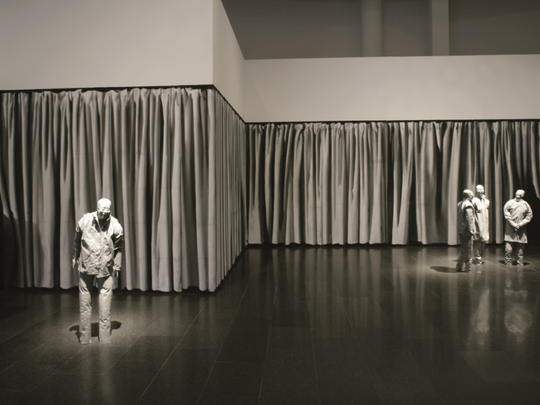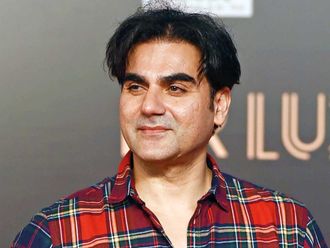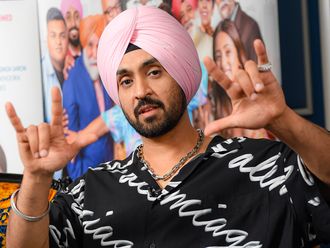
The moment you step into From Barcelona to Abu Dhabi, contemporary artworks draw your eye in every direction. Playful sculptures, surreal paintings, films that invite your senses into a fluid dance for your imagination, and much, much more are yours to explore in Manarat Al Saadiyat.
Its official title is From Barcelona to Abu Dhabi: Works from the Barcelona Museum of Contemporary Art (MACBA) in dialogue with the Emirates. The exhibition — the first of its kind in the region — not only lives up to this promise but takes it one step further by showcasing humanity’s universal connections through film, sculpture, painting, installation, drawing, photography, light works and conceptual pieces that transcend language and culture in an increasingly-divisive world.
Organised by the Abu Dhabi Music and Arts Foundation (ADMAF) as part of its Abu Dhabi Festival, the exhibition, which marks the launch of ADMAF’s new Visual Arts Programme, is open to the public until March 17. Co-curated with Ferran Barenblit, the director of the Barcelona Museum of Contemporary Art (MACBA), and Nasser Abdullah, the chairman of the Emirates Fine Arts Society, it features pioneering works from the past 90 years showcasing a breadth of styles by 70 artists, including 20 Emiratis.
“Well, the collection from Barcelona is truly about art from all over the world covering a lot of history of different cultures. From the UAE’s perspective, we want to respond to this collection with our view, history and heritage while connecting the themes from the art coming in as well as the UAE art scene… Emirati artists displayed next to these international artists with works produced in the early 20s and 30s, it is a great opportunity to show the universal human experience through art,” said Abdullah.
What makes us human
He further explained: “We started with the collection from MACBA curated by Barenblit and once we saw the selection from Barcelona, we selected artworks from the UAE that would tesselate with the theme and concept of the exhibition which explores the lines of what makes us human.”
The artworks by some of the most prominent artists of the modern and contemporary eras, including Alexander Calder, Sol LeWitt, Anthony McCall, Lawrence Weiner, Piero Manzoni and Antoni Tàpies, in dialogue with artworks by pioneers of UAE contemporary practice, including Hassan Sharif, Mohammed Kazem and Ebtisam Abdul Aziz.
“We achieved this I think by showcasing artists from different generations including Hassan Sharif, who started practicing in the 60s and 70s and younger artists are just emerging into the scene following their studies in art and experiencing the world,” said Abdullah.
He added: “So, it is an incredible thing to see the works across so many different generations of artists and the variety of artworks stemming from the UAE… [i]t really shows how expansive and extensive the contemporary art scene in the UAE is.”
Abdullah also offered a quick overview for visitors to help guide them through the expansive artworks on display.
“Overall, [it] has three main themes and sections that the artworks are categorised into. It starts with the Figure section which focuses on human and the practices of humans. The second section is Environment where the focus is on our lives together as humans, how we define our use of space and the rules we establish to live with each other and within our surrounding environment. The third section is Form, which is the more experimental section as it focuses on art itself and the production of art,” he said.
Among the work on display are Symbols and Untitled, two black and white drawings by Emirati artist Mohammed Ahmed Ibrahim, who is based in Khor Fakkan. Each piece features a distinctive take on repetitive symbols that seem simple at first glance but reveal a hidden depth the longer you gaze at them.
“They focus on symbolism and a lot of it stems from repetition that bring forth symbols, movements or formations. This repetition is almost meditative and is an essential part of creating the work as it takes the mind into new spaces of unconsciousness or sub-consciousness, the place of thought and creativity,” he explained.
Given the vast, eclectic artworks featured in the exhibition, I wondered whether Abdullah and Ibrahim had any particular piece that had captured their interest. It proved to be a rather tricky question for both the co-curator and artist.
“Oh, the exhibition is so expansive and amazing! I cannot pick just one from the MACBA collection! There is such an incredible range from the UAE too!” Abdullah said.
He added: “We have Mohammed Kazem showcasing his experiences as a human in the Figure section — he has a piece called Scale which is a pyramid of scales holding a smaller group of scales, all hanging to one single scale holding all the others. This pyramid is the shape of any human system. The top of the pyramid is responsible for those beneath. It is so impressive.”
Ibrahim agreed: “I’m interested in all the works from the artists as part of the museum’s collection to the fellow artists form the UAE! I am so excited to see the whole collection open.”
He further noted: “The exhibition is unique as it shows the humanity that connects everyone universally to the public; showing the commonality of what defines us as humans and the comparison in thinking across the world. I am very proud to have my work alongside the fantastic host of artists from around the world as well as with fellow artists from the UAE.”
From Barcelona to Abu Dhabi has already proven to be a hit with visitors, who can be found transfixed at various locations throughout the exhibition.
“I think what stands out though is the vast collection from MACBA that is coming in. It is so important historically and one of the biggest collections of contemporary art. MACBA’s collection in its entirety exceeds 6,000 pieces showing the contemporary movement around the world,” explained Abdullah.
Would he be interested in organising a similar exhibition in other international locations — and if he had a city in mind — or perhaps have a sister event in Barcelona?
“Definitely, if given the chance! It would be a great opportunity. As is the opportunity to be included in the exhibition here…I cannot comment or pick a singular city but if given the chance, I believe that the history of art is the major connector and the history is an important aspect to focus on in the future,” Abdullah said.
For now, the co-curator and the artist are content to share their infectiously enthusiastic hopes and expectations for the exhibition, which they agree is quite unique in both scope and diversity of artworks on display.
“I think it will be an experience. To see the history of contemporary art from all over the world and see the big picture of the contemporary art scene in the UAE. We want to showcase the growth of the UAE art scene… it is such a great opening for Emirati artists to be elevated to global and international levels. I hope I have done well with this exhibition and that visitors enjoy it and experience it,” said Abdullah.
“I hope they enjoy it. I hope they read into it and take away their own interpretations as well as enjoying the whole exhibition,” said Mohammed.
Nathalie Farah is a writer based in Abu Dhabi.
To learn more about the exhibition, please visit www.abudhabifestival.ae













